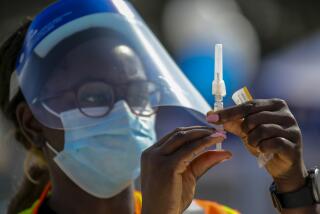A doctor speaks of losing touch
- Share via
Taking good care of a patient also includes, quite literally, keeping in touch. But the growing fear in medicine of dangerous infectious germs and diseases is making physical contact less common in hospital rooms and doctors’ offices, says an Oakland-based doctor.
In an essay published Monday, Dr. Leif Hass recounts his 10-year-old daughter’s hospitalization from MRSA (methicillin-resistant staphylococcus aureus) followed by his own infection and hospitalization. Although vowing to take more precautions against the spread of disease among his patients and his family, Hass describes his longtime reluctance to wear plastic gloves while interacting with patients because of the “barrier” gloves create.
He describes caressing the forehead of an elderly patient in pain in a gesture of comfort and observes: “The smooth glide of skin on skin is missing. My hands, sweaty in the vinyl gloves, move less fluidly than they otherwise would. There is a loss of what could have been a brief, soothing moment for both of us. Even in her delirium, I imagine she can tell this is an institutional comforting because of the feel and smell of plastic.”
Medical guidelines today advise healthcare personnel to use alcohol-based foam products rather than gloves except in cases where drug-resistant germs are known to be present, Hass notes. But with the increase in antibiotic-resistant bugs, it may not be long before doctors and nurses begin wearing gloves all of the time.
Losing the warmth of human touch and all it conveys would be sad, Hass writes, and would necessitate other ways for healthcare professionals to connect emotionally with their patients.
“A hand on the shoulder or knee or a thoughtful physical examination, I believe, can make a patient understand at a deep nonverbal level you are there for them,” Hass writes.
What, if anything, can replace a healing touch?
The essay appears in the September-October issue of the Annals of Family Medicine.
-- Shari Roan / Los Angeles Times
Return to Booster Shots blog.






